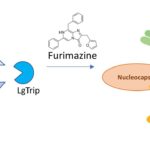The Car Diagnostic Connector Obd2 is a standardized port in your vehicle that allows access to the car’s self-diagnostic system for retrieving diagnostic trouble codes (DTCs) and real-time data, and you can get it through CAR-TOOL.EDU.VN. This article will give you a comprehensive guide to understanding the OBD2 connector, its history, standards, and how to use it for vehicle diagnostics.
Contents
- 1. Understanding the Car Diagnostic Connector OBD2
- 1.1 Is My Car OBD2 Compatible?
- 1.2 A Look at OBD2 History
- 1.3 What About the Future of OBD2?
- 2. Diving Into OBD2 Standards
- 2.1 Unpacking the OBD2 Connector [SAE J1962]
- 2.2 Distinguishing OBD2 Connector – Type A vs. B
- 2.3 OBD2 and CAN Bus [ISO 15765-4]
- 2.4 CAN Identifiers (11-bit, 29-bit)
- 2.5 OBD2 vs. Proprietary CAN Protocols
- 2.6 Bit-Rate and ID Validation
- 2.7 Unveiling Five Lower-Layer OBD2 Protocols
- 3. Transporting OBD2 Messages via ISO-TP [ISO 15765-2]
- 4. The OBD2 Diagnostic Message [SAE J1979, ISO 15031-5]
- 4.1 Example: OBD2 Request/Response
- 4.2 The 10 OBD2 Services (Modes)
- 4.3 Decoding OBD2 Parameter IDs (PIDs)
- 4.4 OBD2 PID Overview Tool
- 5. How to Log and Decode OBD2 Data
- 5.1 Test Bit-Rate, IDs & Supported PIDs
- 5.2 Configure OBD2 PID Requests
- 5.3 DBC Decode Raw OBD2 Data
- 6. OBD2 Multi-Frame Examples [ISO-TP]
- 6.1 Example 1: OBD2 Vehicle Identification Number (VIN)
- 6.2 Example 2: OBD2 Multi-PID Request (6x)
- 6.3 Example 3: OBD2 Diagnostic Trouble Codes (DTCs)
- 7. OBD2 Data Logging – Use Case Examples
- Logging data from cars
- Real-time car diagnostics
- Predictive maintenance
- Vehicle blackbox logger
- FAQ about Car Diagnostic Connector OBD2
1. Understanding the Car Diagnostic Connector OBD2
What exactly is a car diagnostic connector OBD2? The On-Board Diagnostics II (OBD2) system is your car’s built-in self-diagnostic system, a standardized protocol that enables you to extract diagnostic trouble codes (DTCs) and real-time data via the OBD2 connector for faster troubleshooting.
OBD2 has likely crossed your path before. Have you ever seen the malfunction indicator light on your dashboard? It’s your car signaling an issue. Mechanics use an OBD2 scanner, connected to the OBD2 16-pin connector near the steering wheel, to diagnose the problem. The scanner sends ‘OBD2 requests’ to the car, which responds with data like speed, fuel level, or DTCs, speeding up the troubleshooting process.
1.1 Is My Car OBD2 Compatible?
Most likely, yes. Virtually all modern non-electric cars support OBD2, with many operating on CAN bus. However, older cars might have a 16-pin OBD2 connector but lack full OBD2 support. Compliance can be determined by the car’s purchase location and year.
 Does My Car Have OBD2?
Does My Car Have OBD2?
1.2 A Look at OBD2 History
The history of OBD2 stems from California, where the California Air Resources Board (CARB) mandated OBD in all new cars from 1991 onwards for emission control, after studies from the University of California, Berkeley, in 1988 indicated rising concerns over air quality. The Society of Automotive Engineers (SAE) recommended the OBD2 standard, standardizing DTCs and the OBD connector across manufacturers (SAE J1962).
The OBD2 standard was introduced gradually:
- 1996: OBD2 became mandatory in the USA for cars and light trucks.
- 2001: Required in the EU for gasoline cars.
- 2003: Required in the EU for diesel cars (EOBD).
- 2005: OBD2 was required in the US for medium-duty vehicles, impacting manufacturers like Ford and GM, as highlighted in a 2004 report by the EPA.
- 2008: US cars were required to use ISO 15765-4 (CAN) as the OBD2 basis, which was noted in a study from the University of Michigan Transportation Research Institute.
- 2010: Finally, OBD2 was required in US heavy-duty vehicles.
1.3 What About the Future of OBD2?
OBD2 is expected to remain, but its form may change. Important trends include:
- Electric Vehicles (EVs): Legislated OBD2 was designed for emissions control. Electric vehicles aren’t required to support OBD2, and most modern EVs don’t support standard OBD2 requests, as reported in a 2022 analysis by the International Council on Clean Transportation. Instead, they use OEM-specific UDS communication.
- Alternatives: Modern alternatives like WWH-OBD (World Wide Harmonized OBD) and OBDonUDS (OBD on UDS) enhance OBD communication by using the UDS protocol as a base.
- OBD3: Adding telematics to cars for remote diagnostics and emissions testing. OBD3 would add a radio transponder to cars, sending the VIN and DTCs via WiFi to a central server.
- Data Access: The German car industry aims to restrict third-party access to OBD2 data, collecting data in a central server, giving manufacturers control over automotive big data, a proposal debated for security and commercial reasons.
2. Diving Into OBD2 Standards
On-board diagnostics (OBD2) acts as a higher layer protocol, like a language, while CAN is a communication method, akin to a phone. This analogy positions OBD2 alongside other CAN-based higher-layer protocols such as J1939, CANopen, and NMEA 2000.
The OBD2 standards detail the OBD2 connector, lower-layer protocols, and OBD2 parameter IDs (PID). These standards fit into a 7-layer OSI model. The SAE and ISO standards cover several layers, reflecting OBD standards in the USA (SAE) and EU (ISO). Some standards are technically equivalent, such as SAE J1979 vs. ISO 15031-5 and SAE J1962 vs. ISO 15031-3.
2.1 Unpacking the OBD2 Connector [SAE J1962]
The 16-pin OBD2 connector, detailed in SAE J1962 / ISO 15031-3, provides easy access to your car’s data.
Key points:
- The connector is near the steering wheel.
- Pin 16 provides battery power, even when the ignition is off.
- The OBD2 pinout depends on the communication protocol.
- The most common lower-layer protocol is CAN bus, with pins 6 (CAN-H) and 14 (CAN-L) typically connected.
2.2 Distinguishing OBD2 Connector – Type A vs. B
You might encounter both type A and type B OBD2 connectors, with type A common in cars and type B in medium and heavy-duty vehicles. They share similar OBD2 pinouts but have different power supply outputs (12V for type A and 24V for type B). The baud rate often differs, with cars using 500K and heavy-duty vehicles using 250K (with recent support for 500K).
Type B OBD2 connectors have an interrupted groove in the middle. A type B OBD2 adapter cable will be compatible with both types A and B, while a type A will not fit into a type B socket.
2.3 OBD2 and CAN Bus [ISO 15765-4]
Since 2008, CAN bus has been the required lower-layer protocol for OBD2 in all cars sold in the US, as per ISO 15765.
ISO 15765-4 (Diagnostics over CAN or DoCAN) is a set of restrictions on the CAN standard (ISO 11898). It standardizes the CAN interface for test equipment, focusing on the physical, data link, and network layers:
- CAN bus bit-rate: 250K or 500K.
- CAN IDs: 11-bit or 29-bit.
- Specific CAN IDs are used for OBD requests/responses.
- Diagnostic CAN frame data length: 8 bytes.
- OBD2 adapter cable: max 5 meters.
2.4 CAN Identifiers (11-bit, 29-bit)
OBD2 communication involves request/response messages. Most cars use 11-bit CAN IDs for OBD2 communication. The ‘Functional Addressing’ ID is 0x7DF, which asks all OBD2 compatible ECUs if they have data on the requested parameter. CAN IDs 0x7E0-0x7E7 can be used for ‘Physical Addressing’ requests from specific ECUs.
ECUs respond with 11-bit IDs 0x7E8-0x7EF. The most common response ID is 0x7E8 (ECM, Engine Control Module), and 0x7E9 (TCM, Transmission Control Module) to some extent.
Some vehicles use extended 29-bit CAN identifiers. Here, the ‘Functional Addressing’ CAN ID is 0x18DB33F1. Responses have CAN IDs 0x18DAF100 to 0x18DAF1FF (typically 18DAF110 and 18DAF11E). The response ID is shown in the ‘J1939 PGN’ form, specifically the PGN 0xDA00 (55808), marked as ‘Reserved for ISO 15765-2’ in the J1939-71 standard.
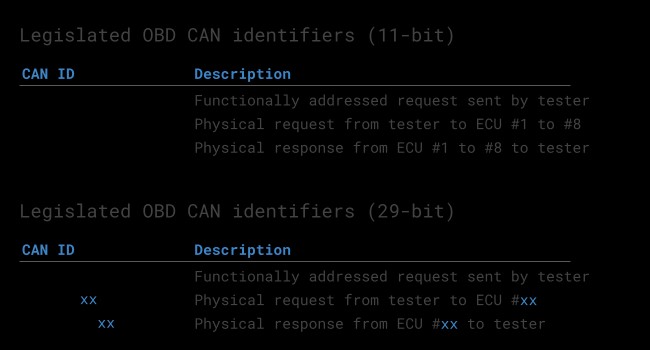 OBD2 OBD CAN bus Identifiers 7DF 7E8 7E0
OBD2 OBD CAN bus Identifiers 7DF 7E8 7E0
2.5 OBD2 vs. Proprietary CAN Protocols
Your car’s ECUs do not rely on OBD2 to function. Each OEM implements their own proprietary CAN protocols. These protocols may be specific to the vehicle brand, model, and year. If you’re not the OEM, you normally can’t interpret this data unless you reverse engineer it.
Connecting a CAN bus data logger to your car’s OBD2 connector might show the OEM-specific CAN data, typically broadcast at 1000-2000 frames/second. However, newer cars have a ‘gateway’ blocking access to this CAN data, enabling only OBD2 communication via the OBD2 connector.
OBD2 is an ‘extra’ higher-layer protocol in parallel to the OEM-specific protocol.
2.6 Bit-Rate and ID Validation
OBD2 uses two bit-rates (250K, 500K) and two CAN ID lengths (11-bit, 29-bit), resulting in 4 potential combinations. Modern cars commonly use 500K and 11-bit IDs, but external tools should verify this systematically.
ISO 15765-4 provides recommendations for performing a systematic initialization sequence to determine the relevant combination. OBD2 compliant vehicles must respond to a specific mandatory OBD2 request, and transmitting data with an incorrect bit-rate causes CAN error frames.
Newer versions of ISO 15765-4 consider that vehicles may support OBD communication via OBDonUDS rather than OBDonEDS. OBDonEDS (OBD on emission diagnostic service as per ISO 15031-5/SAE J1979) is used in most non-EV cars today, while WWH-OBD is primarily used in EU trucks/buses.
To test for the ‘protocol’ of OBDonEDS vs OBDonUDS, a test tool may add additional request messages, specifically sending UDS requests with 11-bit/29-bit functional address IDs for service 0x22 and data identifier (DID) 0xF810 (protocol identification). Vehicles that support OBDonUDS must have ECUs that reply to this DID.
2.7 Unveiling Five Lower-Layer OBD2 Protocols
CAN serves as the lower-layer basis for OBD2 in most cars as per ISO 15765. Inspecting older cars (pre-2008) requires knowing the other four lower-layer protocols used as the basis for OBD2. The pinouts can determine which protocol is used in your car.
- ISO 15765 (CAN bus): Mandatory in US cars since 2008, now used in most cars.
- ISO14230-4 (KWP2000): The Keyword Protocol 2000 was common for 2003+ cars in Asia.
- ISO 9141-2: Used in EU, Chrysler & Asian cars in 2000-04.
- SAE J1850 (VPW): Used mostly in older GM cars.
- SAE J1850 (PWM): Used mostly in older Ford cars.
3. Transporting OBD2 Messages via ISO-TP [ISO 15765-2]
All OBD2 data is communicated on the CAN bus through ISO-TP (ISO 15765-2), enabling communication of payloads exceeding 8 bytes, necessary in OBD2 when extracting the VIN or DTCs. ISO 15765-2 enables segmentation, flow control, and reassembly.
Often, the OBD2 data fits in a single CAN frame. ISO 15765-2 specifies the use of a ‘Single Frame’ (SF), where the 1st data byte (PCI field) contains the payload length (excluding padding), leaving 7 bytes for OBD2 communication.
4. The OBD2 Diagnostic Message [SAE J1979, ISO 15031-5]
To understand OBD2 on CAN, consider a raw ‘Single Frame’ OBD2 CAN message. An OBD2 message has an identifier, data length (PCI field), and data, split into Mode, parameter ID (PID), and data bytes.
4.1 Example: OBD2 Request/Response
Consider this example request/response for ‘Vehicle Speed’.
An external tool sends a request message to the car with CAN ID 0x7DF and 2 payload bytes: Mode 0x01 and PID 0x0D. The car responds via CAN ID 0x7E8 and 3 payload bytes, including Vehicle Speed in the 4th byte, 0x32 (50 in decimal form).
Looking up the decoding rules for OBD2 PID 0x0D, the physical value is 50 km/h.
4.2 The 10 OBD2 Services (Modes)
There are 10 OBD2 diagnostic services (or modes). Mode 0x01 shows real-time data, while others show/clear DTCs or show freeze frame data.
Vehicles don’t have to support all OBD2 modes and may support modes outside the 10 standardized modes (OEM-specific OBD2 modes).
In OBD2 messages, the mode is in the 2nd byte. In the request, the mode is included directly (e.g. 0x01), while in the response 0x40 is added to the mode (e.g., resulting in 0x41).
4.3 Decoding OBD2 Parameter IDs (PIDs)
Each OBD2 mode contains parameter IDs (PIDs). For example, mode 0x01 contains ~200 standardized PIDs with real-time data on speed, RPM, and fuel level. Vehicles don’t have to support all OBD2 PIDs in a mode; most support only a small subset.
If an emissions-related ECU supports any OBD2 services, it must support mode 0x01 PID 0x00. The vehicle ECU informs whether it supports PIDs 0x01-0x20 in response to this PID. PID 0x00 is a fundamental ‘OBD2 compatibility test’. Further, PIDs 0x20, 0x40, …, 0xC0 can be used to determine support for the remaining mode 0x01 PIDs.
4.4 OBD2 PID Overview Tool
SAE J1979 and ISO 15031-5 appendices have scaling info for standard OBD2 PIDs, allowing you to decode the data into physical values.
For a mode 0x01 PID, check out our OBD2 PID overview tool, helping you construct OBD2 request frames and dynamically decode OBD2 responses.
5. How to Log and Decode OBD2 Data
This section demonstrates logging OBD2 data with the CANedge CAN bus data logger, available for consultation with CAR-TOOL.EDU.VN.
The CANedge allows configuration of custom CAN frames to be transmitted, suitable for OBD2 logging. Connect the device to your vehicle via our OBD2-DB9 adapter cable.
5.1 Test Bit-Rate, IDs & Supported PIDs
ISO 15765-4 describes how to determine which bit-rate and IDs are used by a vehicle. Test this with the CANedge:
- Send a CAN frame at 500K and check if successful (else try 250K).
- Use the identified bit-rate for subsequent communication.
- Send multiple ‘Supported PIDs’ requests and review the results.
- Based on response IDs, determine 11-bit vs. 29-bit.
- Based on response data, see what PIDs are supported.
Most 2008+ non-EV cars support 40-80 PIDs via 500K bit-rate, 11-bit CAN IDs, and the OBD2/OBDonEDS protocol.
Multiple responses to a single OBD request are common when using the 0x7DF request ID, polling all ECUs for a response. Since all OBD2/OBDonEDS-compliant ECUs must support service 0x01 PID 0x00, there are many responses to this PID. For subsequent ‘Supported PIDs’ requests, fewer ECUs respond. The ECM ECU (0x7E8) itself supports all the PIDs that are supported by other ECUs, so reducing busload can be achieved by only asking this ECU for responses by changing to the ‘Physical Addressing’ CAN ID 0x7E0 for subsequent communication.
 OBD2 bit rate test
OBD2 bit rate test
Send a CAN frame at e.g. 500K, then check if it is successfully sent
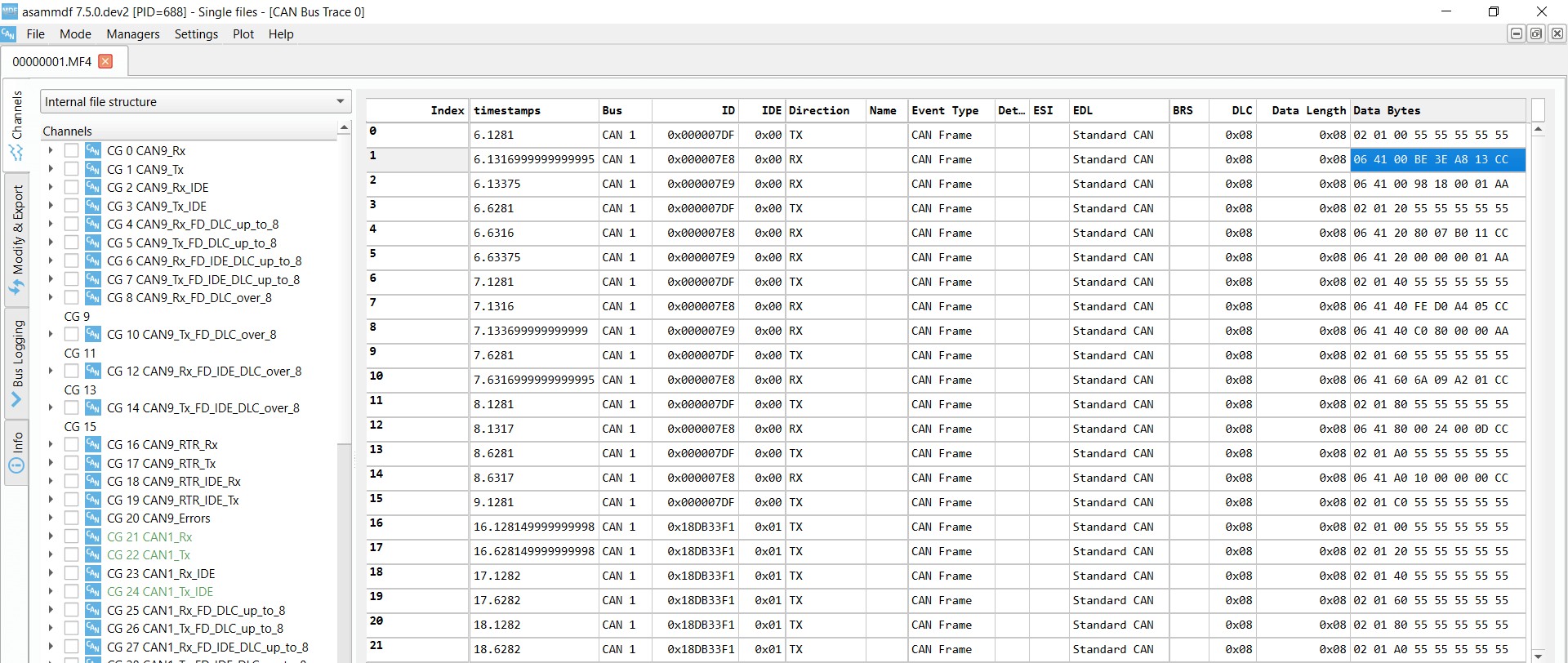 OBD2 Supported PIDs Test
OBD2 Supported PIDs Test
The responses to ‘Supported PIDs’ can be reviewed in asammdf
5.2 Configure OBD2 PID Requests
You now know your vehicle’s supported OBD2 PIDs and the bit-rate and CAN IDs to use.
Next, configure your transmit list with PIDs of interest. Consider:
- CAN IDs: Shift to ‘Physical Addressing’ request IDs (e.g., 0x7E0) to avoid multiple responses to each request.
- Spacing: Add 300-500 ms between each OBD2 request (spamming the ECUs may cause them to not respond).
- Battery drain: Use triggers to stop transmitting when the vehicle is inactive (to avoid ‘waking up’ ECUs).
- Filters: Add filters to record only OBD2 responses (e.g., if your vehicle also outputs OEM-specific CAN data).
The device is now ready to log raw OBD2 data!
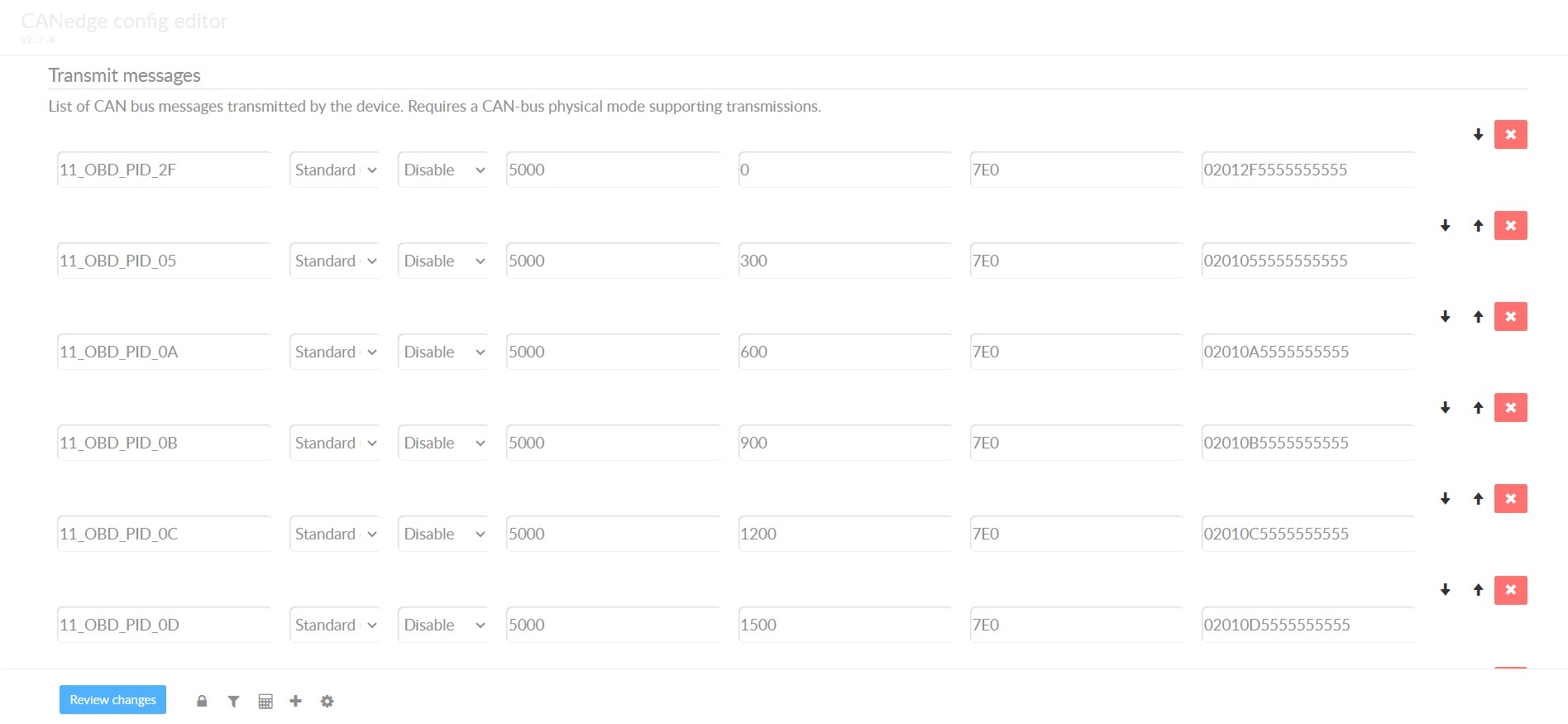 obd2-transmit-list-example-canedge
obd2-transmit-list-example-canedge
An example list of CANedge OBD2 PID requests
5.3 DBC Decode Raw OBD2 Data
To analyze/visualize your data, decode the raw OBD2 data into ‘physical values’ (like km/h or degC).
Find the decoding information in ISO 15031-5/SAE J1979. We provide a free OBD2 DBC file, further consultation at CAR-TOOL.EDU.VN, that makes it easy to DBC decode raw OBD2 data in most CAN bus software tools.
Decoding OBD2 data is more complex than regular CAN signals because different OBD2 PIDs are transported using the same CAN ID (e.g., 0x7E8). The CAN ID isn’t sufficient to uniquely identify what signals are encoded in the payload.
Leverage both the CAN ID, OBD2 mode, and OBD2 PID to identify the signal. This is a form of multiplexing called ‘extended multiplexing’, which can be implemented in DBC files.
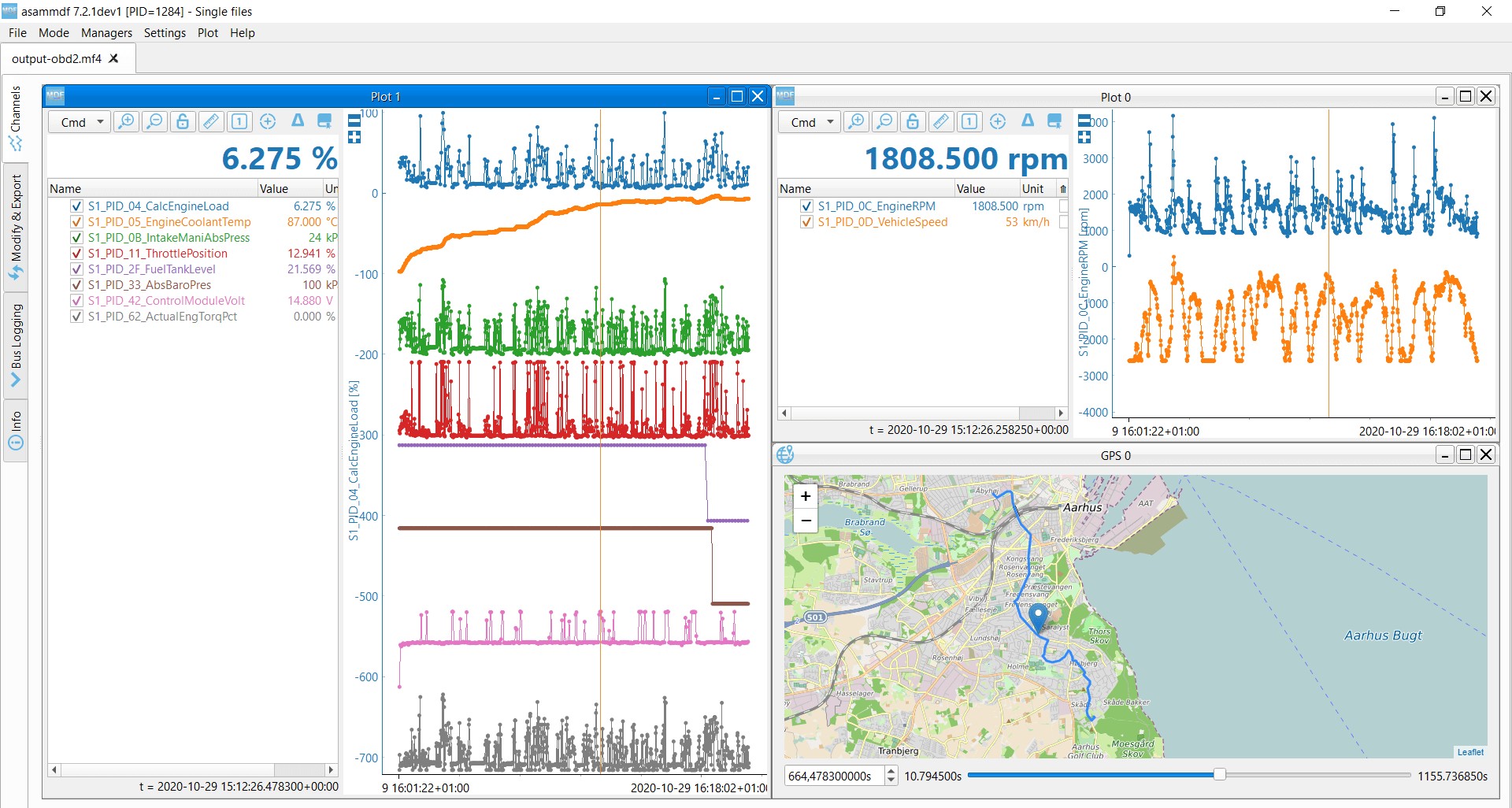 OBD2 data decoded visual plot asammdf CAN bus DBC file
OBD2 data decoded visual plot asammdf CAN bus DBC file
asammdf lets you DBC decode and visualize OBD2 data
6. OBD2 Multi-Frame Examples [ISO-TP]
All OBD2 data is communicated using ISO-TP (transport protocol) as per ISO 15765-2. Most examples reflect single-frame communication. This section provides examples of multi-frame communication.
Multi-frame OBD2 communication requires flow control frames. Transmit a static flow control frame e.g., 50 ms after the initial request frame.
Multi-frame OBD2 responses require CAN software/API tools that support ISO-TP, like the CANedge MF4 decoders.
 OBD2-multi-frame-request-message-vehicle-identification-number
OBD2-multi-frame-request-message-vehicle-identification-number
6.1 Example 1: OBD2 Vehicle Identification Number (VIN)
The Vehicle Identification Number (VIN) is relevant to telematics, diagnostics, and more, with details at CAR-TOOL.EDU.VN. To extract the VIN using OBD2 requests, use mode 0x09 and PID 0x02:
 VIN Vehicle Identification Number OBD2 Example multi-frame
VIN Vehicle Identification Number OBD2 Example multi-frame
The tester tool sends a Single Frame request with the PCI field (0x02), request service identifier (0x09), and PID (0x02). The vehicle responds with a First Frame containing the PCI, length (0x014 = 20 bytes), mode (0x49, i.e., 0x09 + 0x40), and PID (0x02). Following the PID is the byte 0x01, the Number Of Data Items (NODI), in this case 1. The remaining 17 bytes equal the VIN and can be translated from HEX to ASC.
6.2 Example 2: OBD2 Multi-PID Request (6x)
External tools can request up to 6 mode 0x01 OBD2 PIDs in a single request frame. The ECU responds with data for supported PIDs, leaving unsupported PIDs out of the response, if necessary across multiple frames as per ISO-TP.
This feature collects OBD2 data at higher frequency and efficiency, but the signal encoding is specific to your request method, making generic OBD2 DBC files difficult for such use cases. We don’t recommend using this method. Below is an example trace:
 Requesting multiple PIDs in one request
Requesting multiple PIDs in one request
The multi-frame response is similar to the VIN example, but the payload includes the requested PIDs and the data for each. The PIDs are ordered similarly to how they are requested.
Decoding this response via DBC files is difficult, so we don’t recommend this approach for practical data logging unless working with a tool with built-in support. You’ll be working with extended multiplexing, but with multiple cases throughout the payload. Your DBC file needs to account for the specific payload position of each PID, making it difficult to generalize the DBC across vehicles differing in supported PIDs. Handling via pure DBC manipulations is difficult/impossible if sending several multi-PID requests, lacking a method for uniquely identifying these messages.
A custom script could work around this by recording transmit messages, and the script could incorporate logic of interpreting the response message in combination with the request message, but such approaches are difficult to handle at scale.
6.3 Example 3: OBD2 Diagnostic Trouble Codes (DTCs)
Use OBD2 to request emissions-related Diagnostic Trouble Codes (DTCs) from using mode 0x03, i.e., ‘Show stored Diagnostic Trouble Codes’. No PID is included in the request. The targeted ECU(s) will respond with the number of stored DTCs (including potentially 0 if they have none), with each DTC taking up 2 data bytes. Multi-frame responses are necessary when more than 2 DTCs are stored.
The 2-byte DTC value is split into two parts. The first 2 bits define the ‘category’, and the remaining 14 bits define a 4-digit code (displayed in hexadecimal). Decoded DTC values can be looked up in OBD2 DTC lookup tools.
Below is an example of a request to an ECU with 6 DTCs stored.
 OBD2 Diagnostic Trouble Codes DTC CAN Bus Request Response Example
OBD2 Diagnostic Trouble Codes DTC CAN Bus Request Response Example
7. OBD2 Data Logging – Use Case Examples
OBD2 data from cars and light trucks has various use cases:
Logging data from cars
OBD2 data from cars can be used to reduce fuel costs, improve driving, test prototype parts, and insurance.
Real-time car diagnostics
OBD2 interfaces can stream human-readable OBD2 data in real-time for diagnosing vehicle issues.
Predictive maintenance
Cars and light trucks can be monitored via IoT OBD2 loggers in the cloud to predict and avoid breakdowns.
Vehicle blackbox logger
An OBD2 logger can serve as a ‘blackbox’ for vehicles or equipment, providing data for disputes or diagnostics.
Do you have an OBD2 data logging use case? Reach out for free sparring with CAR-TOOL.EDU.VN at 456 Elm Street, Dallas, TX 75201, United States or Whatsapp: +1 (641) 206-8880.
FAQ about Car Diagnostic Connector OBD2
- What type of car diagnostic connector is OBD2?
OBD2 (On-Board Diagnostics II) is a standardized connector used in most modern vehicles for accessing diagnostic data and troubleshooting vehicle issues. It is typically a 16-pin connector, conforming to the SAE J1962 specification. - Where is the OBD2 connector usually located in a car?
The OBD2 connector is commonly found under the dashboard on the driver’s side of the vehicle. It is often near the steering column but may be hidden behind a panel. - What information can be accessed through the OBD2 connector?
The OBD2 connector allows access to various types of vehicle data, including Diagnostic Trouble Codes (DTCs), real-time sensor data (such as engine speed, coolant temperature, and oxygen sensor readings), and vehicle identification information (VIN). - What tools are needed to read data from the OBD2 connector?
To read data from the OBD2 connector, you typically need an OBD2 scanner or scan tool. These tools range from simple handheld devices to more advanced computer-based systems with software for data analysis and diagnostics. - Can I use any OBD2 scanner on any car?
While the OBD2 standard ensures a level of compatibility, not all scanners work with every car. Some advanced functions and vehicle-specific data may require a more specialized or professional-grade scanner. - Is it safe to leave an OBD2 scanner plugged in all the time?
Leaving an OBD2 scanner plugged in continuously is generally not recommended. It can drain the vehicle’s battery over time, especially if the vehicle is not driven regularly. - Can I clear the “Check Engine” light using an OBD2 scanner?
Yes, many OBD2 scanners have the ability to clear Diagnostic Trouble Codes (DTCs), which will turn off the “Check Engine” light. However, it’s important to address the underlying issue that triggered the light in the first place to prevent it from returning. - Are there any privacy concerns with using OBD2 scanners?
Some OBD2 scanners, particularly those with wireless connectivity, may raise privacy concerns. It’s important to use reputable devices and be aware of the data being transmitted and stored. - How can I find out which OBD2 protocols my car supports?
You can find out which OBD2 protocols your car supports by consulting the vehicle’s owner’s manual or by using an OBD2 scanner that can automatically detect the supported protocols. - Where can I find reliable information about OBD2 codes and their meanings?
Reliable information about OBD2 codes and their meanings can be found on websites such as the National Highway Traffic Safety Administration (NHTSA), the Environmental Protection Agency (EPA), and reputable automotive diagnostic sites. You can also consult with certified mechanics or automotive experts. CAR-TOOL.EDU.VN is always ready to help you.
For more intros, see our guides section or contact us on Whatsapp: +1 (641) 206-8880
Need to log/stream OBD2 data? Get your OBD2 data logger today through CAR-TOOL.EDU.VN.
